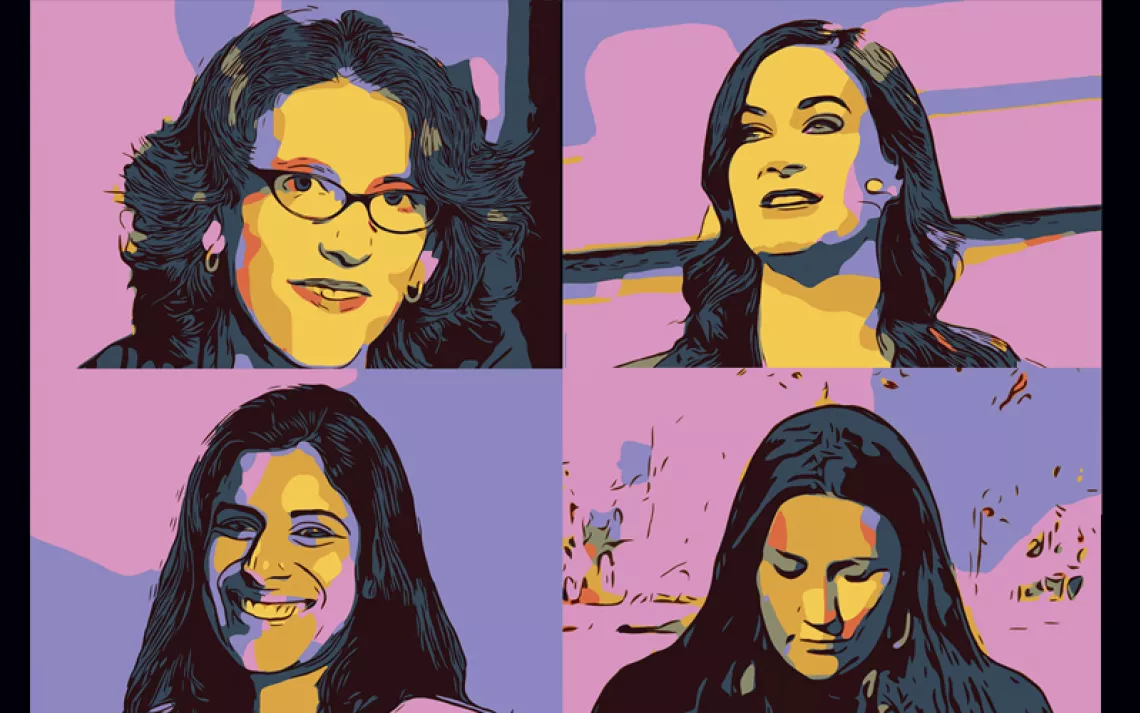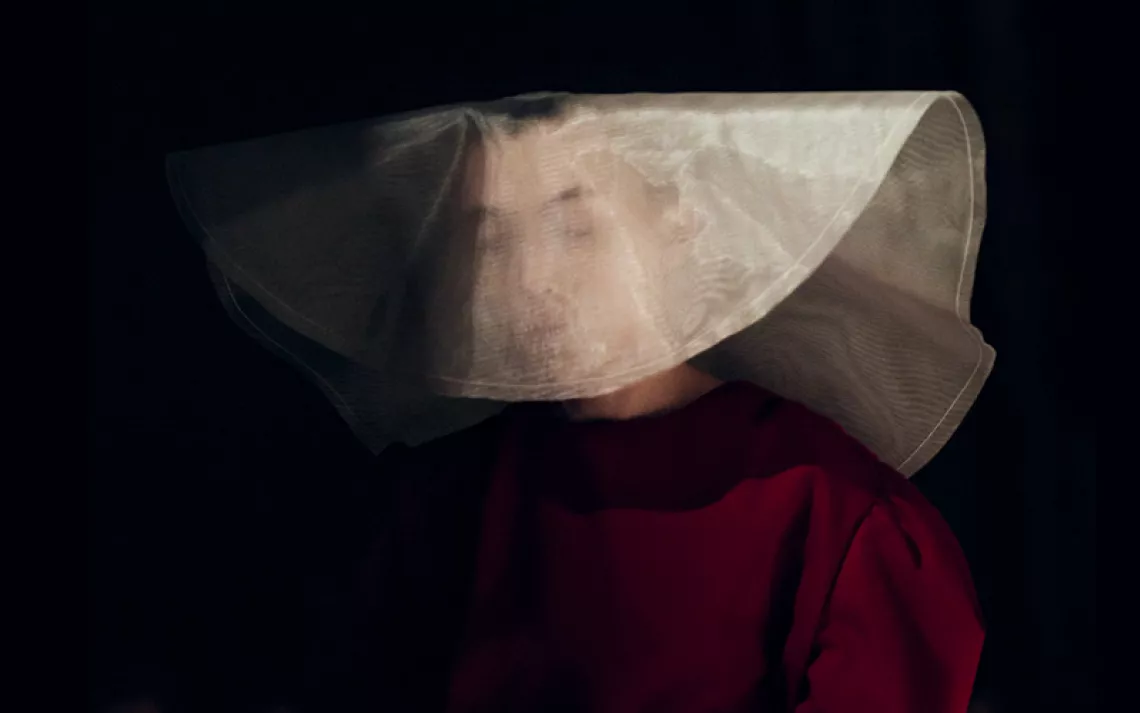A Neighborhood Named Desire
Louisiana demonstrates what’s wrong, and right, with the Bush administration’s favorite form of sex education

Alcee Fortier High School
Teenagers ride to Alcee Fortier High School on the St. Charles Avenue streetcar line, surely the loveliest in America. The trolleys with their wooden seats clatter nicely along tracks on a grass median through uptown New Orleans, trailed by the scent of magnolias. The graceful homes on either side, with wrought-iron terraces and cool front porches, rest half-hidden in the greenery.
Fortier is a stone island in the comfortable residential district, a place kids come to from somewhere else, a school with a dead-end reputation whose mandate is to accept any student, including those kicked out of other schools. Many of its teenagers come from Desire, where the streetcar used to go. You won’t see Desire on Louisiana tourism posters: Its brown-brick housing projects are treeless and miserable, with shattered windows and metal doors opening onto dark interior stairways. Buildings are numbered like cell blocks. Very young mothers wheel babies into the cement bunker of a half-empty corner store, with a wire-mesh anteroom that can be locked quickly to keep out the unwanted.
Basketball hoops hang atilt. Signs: "No animal fighting allowed." Average income: under $5,000 a year.
At the high school, kids excitedly cue up a video in a small, moldy upstairs office. They jostle and point, recognizing themselves in a Valentine’s Day ceremony. "That’s Danny, JV basketball," one boy says. "Shows you can be a jock and not have sex—you could still be looked up to." On screen, one by one, the 30 members of the Pure Hearts Club take the microphone and pledge to abstain from sex until marriage. A school-board member presents each with a silver ring, symbolizing chastity, to wear until then, "on behalf of Almighty God."
Fortier has a thousand students, but on a recent report-card conference night only 14 parents showed up. At the chastity pledge ceremony, however, some 200 parents and relatives packed the event, wearing their Sunday best.
"Why not take the vow and be sure we don’t come across diseases?" says Victor, 17, whose girlfriend also pledged. Girls outnumber boys two to one in this club, and often join for reasons related to other kinds of stress. Pledging chastity, says one, means "you’re not goin’ through the drama with your mama" anymore. Margella wants to be a computer technician, and travels after school to a local community college for classes she can’t get at Fortier. She took the pledge because "you can’t do two things at one time"—that is, get through school and have a baby. Every girl in the club has a cousin, sister, mother, or friend who dropped out to raise a child.
Abstinence clubs are not only for those who have never had sex. Some teens call themselves "born-again virgins." None of the Fortier kids watching the video is a virgin. "When I broke up with my girlfriend I lost a piece of my mind," says Martee. "Sex relationships get rocky and shaky. You ask yourself, ‘Is that a physical bond or an emotional bond?’"
Suddenly the kids sound like most adolescents, in over their heads, searching, yet full of bravado. "You break up with the guy and you’ve been having sex, it feels so bad, like he is taking something of you away with him when he walks," says Brandy, 17. ("Yes, oh yes," says Domonique, 18, with all the wisdom of a much older woman.) "But you break up and you have not been having sex and you say, well, that’s that, and you can walk ahead."
John Wyseman is the special-education teacher who founded the Pure Hearts Club at Fortier. When he and his wife, Karen, a school administrator, set about to address teen pregnancy in 2002, they decided teaching birth control would be "talking out of both sides of your mouth." So they started the club, now funded partly by the Governor’s Program on Abstinence.

Sign up to receive Sierra News & Views
Get articles like this one sent directly to your inbox weekly.
With this action you affirm you want to receive Sierra Club communications and may vote on policy designated by the Sierra Club Board.
As he walks through the halls, Wyseman, with salt-and-pepper hair drawn into a ponytail, proceeds haltingly because students continuously stop him to talk. While he lacks the evangelical vocabulary of some abstinence-only educators, he does believe that God is involved in the decision to remain chaste. But at Fortier, talk is less about God and more about personal experience; Wyseman understands that motivation comes from more than one place. A graduate in marine biology, Wyseman didn’t want to take any of the local jobs available with oil companies, because he believed they were irresponsible about pollution. So he chose teaching as a temporary fix, which has now lasted 20 years. "Once I thought I was going to be the next Jacques Cousteau," he says ruefully, "but now I’m thinking I’m still doing something right for the environment, getting a message across: ‘Don’t just go out and procreate.’ "
Over half a billion tax dollars have poured into abstinence-only sex education nationwide since House Republicans wrote it into the Welfare Reform Act in 1996. The legislation offers matching grants to districts that adopt its strict guidelines: promoting abstinence from sex until marriage, with contraception discussed only in terms of failure rates. Instructors agree not to tell youngsters how to reduce risk of disease and pregnancy if they are sexually active—a population that numbers half of high-school-age kids. In many if not most programs, the issue is presented in terms of God and morality.
Critics call abstinence-only sex education "fear-based" and dangerously incomplete. Traditional "comprehensive" sex education teaches that abstinence is the only sure way to prevent pregnancy and disease but includes information about birth control as well. While abstinence-only is growing rapidly, funding for comprehensive sex education has remained static, despite its proven ability to reduce teen birth rates.
Nationwide, the birth rate among 15- to 19-year-olds dropped 26 percent in the last decade. (If abstinence education played a part, no rigorous study has yet shown it. The drop is commonly attributed to concern about AIDS and better contraceptive use.) But 13 states, all in the South, still have teen birth rates that, as one report put it, "rival the rates of nations such as Azerbaijan, Egypt, and Mexico." Overall, the United States leads the industrialized world in teen pregnancy and birth rates; nearly half a million children are born to teen moms each year—11.5 percent of all U.S. births.
Baton Rouge lies hot and languid on a steamy twist of the Mississippi River, where boats and barges beat their way between St. Louis and New Orleans. Just up from the banks is Dan Richey’s state capital office. Richey is a hefty, sharp-eyed crusader, and this is his war room, complete with giant map stuck with blue and yellow pins to show where abstinence education yet must go to achieve "total penetration" of Louisiana schools.
Richey is director of the Louisiana Governor’s Program for Abstinence, a front in a national Bush administration campaign. For him, abstinence-only is not just about sex and education, but about a "total cultural revolution," by which he means a "return" to perceived Christian values.
It’s also about politics. The GOP’s interest in abstinence-only education emerged from its conservative-Christian ranks, a sector that George W. Bush cultivated when launching his national political career, and whose support he must maintain in order to win reelection. Bush has been among abstinence-only’s greatest champions since he was governor of Texas, the movement’s incubation chamber. Austin is home to the Medical Institute for Sexual Health, whose founder, Dr. Joe McIlhaney Jr., preaches that birth control and decriminalized abortion lead to sexual revolution, a confusion of proper gender roles, and perdition. While governor, Bush once proclaimed at a conference organized by McIlhaney’s institute that abstinence was the only way for teens to avoid the "Pandora’s box" of premarital sex and to embrace "a life that is physically, and morally, and emotionally healthy."
As a presidential candidate, Bush pledged to increase federal funding for abstinence-only programs to at least $135 million annually to achieve parity with funding for traditional sexuality-education programs that include information about birth control and "safer sex." Last year Congress renewed funding for abstinence-only education, over the objections of the Sierra Club and more than two dozen other groups. Planned Parenthood charged that the programs present adolescents with "misleading, often incomplete information about sex, denying them potentially life-saving knowledge about the use of contraception to prevent disease." The American Medical Association also discounts the effectiveness of abstinence-only education.
In addition to outright grants, the federal government provides $4 in matching funds for every $3 in state funds. Richey says that when he approaches the schools, "we tell them, ‘We’ve got a plan here, it won’t cost you a thing.’ " (All states except California accept abstinence-only monies.) Richey makes no excuses for a sexuality-education program that examines neither sexuality nor birth control. "Talking about contraception is taking them to the edge," Richey says, leaning forward. "Bottom line: When you’re dealing with teenagers, the more sex information you give, the more sex you get."
Major studies, however, including one by the Kaiser Family Foundation, have concluded that traditional comprehensive sex education does not increase sexual activity among teenagers. When a 2001 report from Surgeon General David Satcher said the same, the Bush administration publicly disagreed and failed to reappoint him when his term expired.
For Louisiana seventh-graders, abstinence-only education appears first and foremost to be about terrifying disease: suppurating boils, endless rashes, sterility, cancers, and the physical and psychic morbidity with which they are likely to be punished for having sex before marriage. A 12-lesson video provided with the middle-school study plan is replete with gun-to-the-head allusions ("You don’t know when you’re the one to get the bullet"). In a video skit, kids punctuate each description of a near-sex event by pointing a handgun into the air and firing a single shot.
By high school the idea is to create a cadre of young adults who will not only remain chaste, but promote the broader message, which includes opposition to abortion. At a state convention for the Governor’s Program in Baton Rouge in 2003, hundreds of youngsters from abstinence clubs formed a state board and swore a chastity pledge on the capitol steps administered by a state supreme court justice. Then they lunched with Governor Mike Foster in the governor’s mansion. The lesson: They were part of a movement that could bring them from nowhere into halls of power. Some indeed continued on to Washington, D.C., where among other things, as one 17-year-old says, "We learned to handle the media." Once firmly "on message," as Richey puts it, abstinence education is "about leadership—we especially want to develop those who are going to carry the water."
The message one hears from Richey, his volunteer instructors, and their young pupils is less about health than what Richey calls the "cultural battle," in which promiscuity and reproductive freedom ("code for abortion," says Richey) are pitted against patriotism, a determination to re-criminalize abortion, and fear of God.
(In this black-and-white world, some kids don’t fit at all. The federal abstinence-education guidelines require youngsters be taught that "a mutually faithful monogamous relationship in the context of marriage is the expected standard of human sexual activity." Ask Dan Richey, "What about gay kids?" and his answer is quick and dismissive: "They’re gonna get HIV.")
Hundreds of the federally funded, community-based abstinence-only programs are run by faith-based groups. The Louisiana American Civil Liberties Union found that government abstinence-only funds had paid a minister to train other ministers to spread the message, and that thousands of dollars went to programs that included prayers as well as continuous references to God, Jesus Christ, and the spiritual repercussions of sex before marriage. One film shown in a federally funded program said God covers us "like an umbrella when it rains," but that sex before marriage puts us outside the umbrella where God can’t help us. A statewide caucus in Baton Rouge that instructed high schoolers about the legislative process (and how to use it to fight abortion, for instance) was told "abstinence is the cornerstone of Judeo-Christian belief," and that it was "time to restore the Judeo-Christian heritage in America."
"It’s a way for the Bush administration to funnel funds to groups ideologically in tune with them," says Joe Cook, executive director of the state ACLU, which brought a legal challenge to the Louisiana program. The challenge did not contend that the programs were inaccurate or dangerous, although those were some of its findings. ("It’s not illegal for the government to mislead teenagers—it might be unethical, but not illegal," Cook says.) Instead, the ACLU charged that taxpayer dollars should not be used to fund religious activity. A federal judge ruled that the governor’s program must cease proselytizing or risk defunding.
But with Congress breaking down the walls between church and state, and urging faith-based groups to use federal funds for social services, the abstinence-only movement appears scarcely chastened by the court decision. In Richey’s Baton Rouge office, a one-page handout is now available that says programs may not promote religion, but little else seems to have changed.
"There’s room for abstinence-only, and room for abstinence plus," says Dr. Kevin Stephen, an obstetrician who directs the New Orleans Health Department. "One size doesn’t fit all." Stephen, an African American, says he knows the reach of black churches and has no problem with their sending a celibacy message. (Doctors in New Orleans credit a recent drop in teen pregnancy rates among African-American girls to an effort by black churches to address the issue.) Nevertheless, the first thing a visitor sees in Stephen’s reception room is a bowl of condoms, free and inviting as chocolate kisses. Stephen and his colleagues refuse to be put in a box. "My problem with abstinence-only education is what it doesn’t talk about. You can’t teach [sex education] unless you have a holistic approach."
A staff member at one school that serves Desire would like to be able to offer counseling about birth-control methods through an on-site school clinic for kids who are sexually active. (At Fortier the number is estimated to be 70 percent.) "But my hands are tied," she says. Providing such information would be against the law; merely being suspected of sharing information about contraceptives with students could threaten funding for the other health services the school dispenses, worries the staff member.
University of New Orleans medical anthropologist Martha Ward finds herself torn about the issue. "I’m seeing a major trend—young women choosing celibacy," says Ward, who designed the first women’s-studies program in Louisiana in the early 1970s. "Celibacy culture is not onerous, but protective." Yet she’s uncomfortable to find herself in bed with the abstinence-only movement. Over dinner in the Garden District, talk drifts to a "culture of fear" that she sees descending over the country, and what a perfect fit the typical abstinence-only program is with that atmosphere. Plates of crawfish étouffée have been cleared away, but Ward can’t let go of the dilemma. "They don’t want to reach us, they want to control us," she says. "There’s a creepy factor. It may be that abstinence-only education is a very poor way of presenting this very reasonable choice. We need a vocabulary that doesn’t evoke repression."
The streets of New Orleans on late spring nights are warm and sensuous. Windows stay open, so a neighborhood walk can mean hearing canned television noise or the notes of the next generation’s Neville Brothers from a local club, or catching a smell of incense, hearing a baby cry. It does not seem at such times that a battle is going on for youngsters, in the name of education. Somewhere, unmistakably teenage voices ring out, and laughter.
 The Magazine of The Sierra Club
The Magazine of The Sierra Club



